Menus
- Thin blade
- Single cylinder with variable valve timing, 124.7 cm3, 15 hp and 12.4 Nm, 142 kg, 5,299 euros
- Discovery
- In the saddle
- In the city
- Motorway and expressways
- Departmental
- Circuit
- Part-cycle
- Braking
- Comfort / Duo
- Consumption
- Conclusion
Thin blade
Single cylinder with variable valve timing, 124.7 cm3, 15 hp and 12.4 Nm, 142 kg, 5,299 euros
For several years, small sports cars have made a comeback. From 125 to 300/400 cm3, the market sees the appearance of ever more efficient and attractive machines.. After testing the new Kawasaki Z 125 and Ninja 125, we take the handlebars of the Yamaha YZF-R125. Sales champion since its first appearance in 2008, the pocket sports car was renewed in 2014. This eighth liter represents the best selling Yamaha hypersports, with 36% of the segment, far ahead of the R1, whose manufacturer is celebrating its 20th anniversary. . In this niche, the little tuned machine is, without doubt, among the most attractive, both in style and equipment and in mechanics…. And the 2019 vintage sets the tone again, with aesthetic and mechanical changes and in particular a Variable Valve Actuation system. !
The R-125 is designed and manufactured in Europe for European customers, under the supervision of the Japanese manufacturer, while France takes care of the chassis manufacturing and assembly part in Saint Quentin (Aisne).
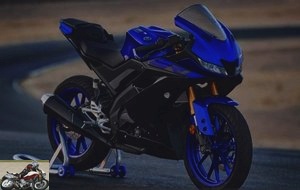
It is around Valencia (Spain), on the road but also on the Ribera circuit, that we test the new YZF-R125.
Discovery
Adopting the style of its predecessors 600 and 1000, the YZF-R 125 offers the most successful design of the moment with in particular more fluidity compared to previous hypersport models.

Hyper compact front face, reduced LED lights around a dummy frontal air intake, the eighth of a liter from the Hamamatsu firm is seductive. The 11-liter steel tank is almost concealed next to a large seat and passenger jump seat. The long aluminum passenger footrest plate supports are less elegantly suspended. More structured, the side fairings have a less smooth surface, linked to a discreet rear loop. The whole gives even more strength to the front of the small YZF.
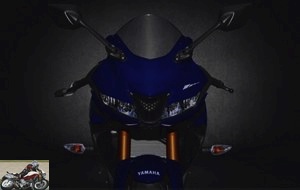
Sporty light weight, 142 kg all the same…., The 125 combines a tubular rear structure with a steel Deltabox frame, modified for this vintage. This shell houses a brand new, state-of-the-art heart.
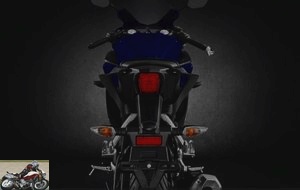
Surprisingly, the 124.7 cm single cylinder³ is of the long stroke type, with a bore ratio of 52.0 x 58.6 mm. Its four valves are operated via a single shaft, now equipped with a Variable Valve Actuation (VVA) system. The system is simple: the two intake cams display a different profile. One controls the main valve rocker at low and mid speed. The other cam, higher, takes over beyond 7,400 revolutions. At this time, a secondary rocker driven by the high cam, is linked to the movement of the main rocker by pushing a stud…. then resulting in a greater lift. Controlled by electronics, this device is therefore simple and reliable. It allows the best possible management of torque and maximum power over a wider operating range. We should thus benefit from more availability at low revs and more usable power at the top of the tachometer. And on this mechanism, everything increases: the diameters of the injection throttle body (+2 mm or 30 mm) and the intake and exhaust valves (+1 mm) increase significantly. As for the air box, it almost doubles in volume, going to 5.5 liters! The combustion chamber is made more compact. The unit thus delivers 15 hp at 9,000 rpm and 12.4 N.m of torque at 8,000 revolutions. This better efficiency should guarantee more intense acceleration, better engine availability and a higher top speed..
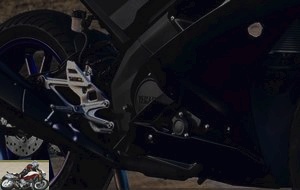
The YZF R-125 has an anti-dribble clutch to stack gears without locking the rear wheel. The cable control is also assisted to reduce lever effort.
The improvements are also made at the cycle part level. A 41mm Kayaba fork with satin gold sheaths installs the front end. Devoid of adjustment and deflecting over 130 mm, it is completed by a Kayaba mono-shock absorber mounted on rods and adjustable in preload. It manages, on 114 mm, a brand new swingarm. A remarkable part of the machine, this imposing "banana" -type element in cast aluminum reinforces its rigidity. Its dimensions and weight are also reduced. An openwork on the left side allows the chain to pass.
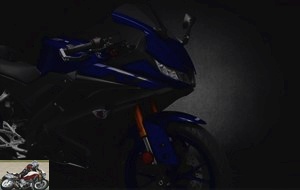
In die-cast aluminum, the thin 17-inch Y multi-spoke rims mimic a forged construction. They fit Michelin Pilot Street models in 100×80 and, now wider at the rear, in 140×75. The radial-mounted brake caliper is returned to the steering gear. Four pistons bite a 292 mm disc. Modified, the retarder opposed to a piston grips a 230 mm wafer. Finally, the ABS ensures the assembly and selector as brake pedal and plates are also made of aluminum.
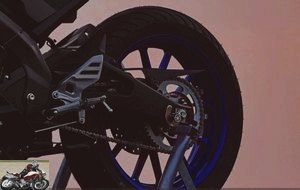
A care that can be found at all levels on the R-125, from the two-tone casings with neat surfaces to the exhaust covered with a plate protecting your boot. And the competition invites itself on board, from the openwork triple clamp mimicking that of the R1 (an evolution of the previous model in fact….) To the standard brake handle protection…. However, we regret the lack of adjustable lever in spacing, penalizing small hands. Regrettable when this bike is mainly aimed at young people from 16 years old (A1 license) and A2.
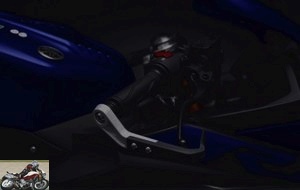
In the saddle
More accessible, the new YZF-R1 lowers its saddle by 5 mm, thus peaking at 820 mm. It’s almost the height of some trails anyway. Thicker foams combine with more attractive ergonomics. The raised and more open handlebars offer a noticeably less extreme position. And the possible recoil on the seat, for the older ones, is appreciable. Sure, leg curl is noticeable, but hey, you wanted a sporty one, no ?
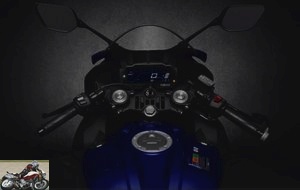
The cockpit demonstrates even greater integration than the previous vintage. Assembly of the elements, fork shaft…. nothing denotes. A new LCD dashboard equips the Yamaha, also "inspired" by that of the R1. It includes a central tachometer surmounted by a large barograph-type tachometer. This display also features adaptive lighting, gear indicator, VVA operation, fuel gauge and clock. On the other hand, more control on the handlebars…. a push-button on the instrument cluster enables the instantaneous average consumption, odometer and two partials to be read successively. And what about warnings…. ? The whole is surmounted by a shiflight very useful for this small displacement, often taken in the towers..
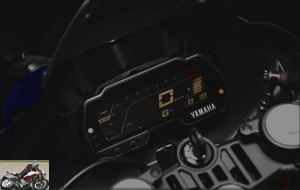
In the city
How good this little mill sounds! We don’t get scared of course, but the sound of the exhaust is pleasant, retaining some low notes. A commendable effort for a renowned instrument maker…. And the single-cylinder has plenty of room, taking our YZF-R125 with gusto through the heavy traffic of the Spanish city. No need to scream the block to start, the mechanics which testify to an appreciable presence, advantage of its variable VVA distribution. Plus, pulling the throttle doesn’t require breaking your wrist.

The mechanics are very flexible, allowing changes in the fifth report. Beyond 5,000 revolutions, the engine delivers appreciable force to the intermediates. It allows dynamic evolutions in town, without knitting too much of the selector. Always a little dry, the selection benefits from an assisted clutch limiting any effort at the lever. Well staged, the gearbox correctly supports city trips. Finally, the large mirrors return a wide and clear field. Now less straightforward, the reduced pressure on the handlebars makes maneuvering and city driving more enjoyable, especially as the Yamaha shines well for its category..

The lightness of the YZF-R125 is its best asset, both in everyday life and on trips further afield where we now take it..
Motorway and expressways
Available and voluntary, the mechanics quickly take the little Yamaha to the legal limits. Enough to catch a 135 km / h counter at full 6, dab on the tank near the switch (11,000 turns). Delivering a few uncomfortable vibrations, the small single-cylinder is at ease in the towers.
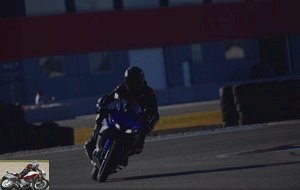
However, the notion of comfort on long sports trips remains relative. Leg flexion and limited protection if the bust is raised do not encourage long motorway journeys. And the mechanics will only support this long-term treatment moderately. To get the quintessence of the YZF-R125, we will choose a wilder network or, of course, the circuit.
Departmental
Decidedly demonstrative, the engine demonstrates a fairly convincing usable range. If the contribution of variable admission is not very sensitive to its implementation, the tuning fork convinces with its presence. And just as much is the limpid cycle part of the machine. Oversized, the fork remarkably absorbs the defects of the roads, as the rear shock absorber. Rigid and lively, the R-125 shifts from angle to angle without downtime, maintaining good cornering speed. The revivals are of course progressive, but the single cylinder energizes the pocket sports car very well. The cam change of the VVA system is not sensitive. Only a slightly higher-pitched sound from the exhaust could indicate a slightly faster revving ….

Sometimes a little rough, the selection remains precise and the limited-slip clutch allows you to enter three gears at once without locking the rear wheel. On the road, we stay on an effective range between 8,000 laps and the red zone, alerted by the shiftlight a few hundred laps before this limit. The reduced test on the secondary network did not give us the opportunity to see all the facets of the new YZF R-125 on this point. However, two track sessions demonstrate the sportiness of the chassis..
Circuit
This is of course the place of revelation for such a motorcycle. The holy chapel is called the Ribera circuit, 2,200 m of tortured, technical press and 400 m of a single straight line…. A dream turnstile for disciple of the enchanted curve. Between the multiple baffles, we again note the lightness of the R-125 and its ability to be taken from one angle to another. Much shorter (-30 mm), the wheelbase makes the Yamaha even more agile. Especially since the handlebars more open and raised further optimize the downforce. We therefore force less at the controls of the 2019 vintage.

Another quality, the tires perfectly withstand the use of the track. The temperature rises quickly and the grip is flawless. Enough to further increase the pace and speed of cornering.

The grip of the front brake causes an immediate and frank attack of the caliper, but remains controllable. This force is perfectly received by the front axle. The fork admits excellent management of the dive from the start of the race. On the angle, the stability is beyond reproach and the neutrality of the machine leaves the pilot in control..

Part-cycle
Deltabox steel frame, superb oversized aluminum swingarm, large diameter inverted fork…. the YZF R-125 knows how to speak to amateurs of beautiful work. The shock could be more preloaded, but the whole thing is quite honestly tuned for everyday use. And the damping quality is the best.
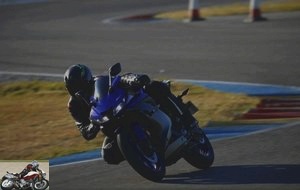
Braking
The on-board equipment is proving to be extremely efficient. The bite of the caliper is always so immediate, almost brutal if one is careful or on reflex braking. Fortunately the 125 now has life-saving ABS…. The rear retarder is much more adjustable, but its strength is also noticeable.
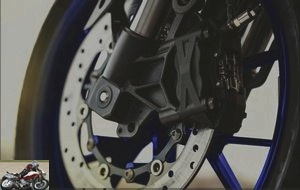
Comfort / Duo
With its new ergonomics and a thicker saddle, solo comfort is very correct. You will move a passenger around town, but make sure that their size remains in line with the machine: compact ….
Consumption
With an average of 2.4 liters / 100 km (computer), the 11 liters of the tank should provide 400 km of autonomy…. What to ride for a long time.
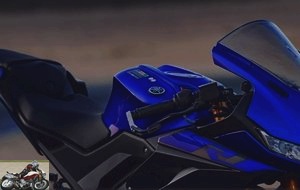
Conclusion
With its new successful aesthetic, its high-end equipment and its demonstrative mechanics, the Yamaha YZF R-125 easily secures a place on the podium of the segment. The advantage of VVA variable valve timing is felt especially at low and mid-speed where the engine gives the machine a pleasant boost. And, more livable on a daily basis, the little sportswoman becomes really endearing.
The sportswoman plays a high-pitched score. But, priced at € 5,299, the YZF R-125 has the luxury of being less expensive than its predecessor. An advantage in the face of severe competition and, also, less expensive. Efficient, the Suzuki GSXR 125 sells for € 4,099 and the new Kawasaki Ninja 125 € 4,899. On the European side, the KTM RC 125 is priced at 4.899 € and the superb Aprilia RS 125 requires 4.929 €.
Sleek, dynamic and well finished, the new YZF R-125 fulfills its role as the first in its class. With it, Yamaha again puts the segment in tune, but at a high price.

Strong points
- Seductive style
- Evidence of handling
- Demonstrative engine
- Convincing VVA system
- Agility and precision of the chassis
- Ergonomics
- Braking
- Suspension
Weak points
- A bit high price
The technical sheet of the Yamaha YZF-R125
Test conditions
- Route: variable surface road, dry.
- Technical track circuit
- Weather: cold and sunny
- Problem encountered: ras
Test equipment
- Scorpion Exo 2000 Evo Air Helmet
- Dainese Laguna Seca suit
- Dainese Torque D1 Boots
- Dainese Full Metal D1 Gloves
- Vanucci Nubuck Jacket
- Jean Vanucci Armalith 2.0
Related articles
-
200 hp at 13,500 rpm, 112 N.m at 11,500 rpm, 199 kilos with full fuel, from € 18,499 Is the Crossplane engine an advantage in road use ? Even if the…
-
Roadster Sport-Heritage Fasters Sons Following on from the XSR 700, Yamaha today unveils its new Sport-Heritage XSR 900 roadster in dynamic fashion….
-
Small (Force of) strike ! Unchanged since 2010, the Yamaha R6 remains a benchmark in the Supersports segment. Light and radical, it is as pleasant on the…
-
Yamaha MT-07 2021 motorcycle test
Generic anti-depressant Twin CP2, 689 cm3, 73.4 hp, 67 Nm, 184 kg, 7,299 euros The face of bikers in the medium-displacement segment, the Yamaha MT-07…
-
Yamaha Tracer 9 and Tracer 9 GT motorcycle test
Cross-country sprinters 3 cylinders in line, 889 cm3, 119 hp and 93 Nm, 213 kg full made, from 11,499 euros Road trail, sport-touring, road … the names…
-
The age of Reason Since 2015, the Sport-Touring segment has experienced a new lease of life, of which Yamaha is the main instigator, with, in particular,…
-
A tri-wheeler called pleasure Three cylinders, 4T, 84.6 kW (115.0 hp), 87.5 N.m (8.9 m.kgf), 263 kg, 14,999 euros With the arrival in 2006 of the MP3…
-
Evil Torgnole power 10 New sporty troublemaker in the successful Yamaha range, the MT10 sets new standards in terms of four-cylinder mechanics. Its…
-
Yamaha Fazer FZ8 motorcycle test
Ho-mo-gene! (finally) Poor Yamaha FZ-8. When it arrived on the market in 2010, the new mid-size roadster from the tuning forks firm had all the assets…
-
Yamaha VMax 1700 motorcycle test
The return of a legend The return of the good, the bad and the tonic-truante. Certain celestial objects cross our orbit according to a periodicity which…